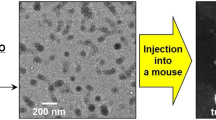Abstract
The objective of this study is to optimize the parameters in labeling near-infrared (NIR)fluorescent dye cypate to protein drugs for in vivo optical imaging of drug distributions in animal model. l-ASparaginase (l-ASNase) was used as a protein drug model for the study. To achieve this goal, various labeling conditions, including different catalysts, feed ratios of all components, pH conditions, temperatures, and reacting durations, were investigated. The dye-to-protein (D/P) ratio and enzymatic activity were designated as the metric to evaluate the labeling process. The stability of the cypate–protein conjugate in blood serum and its distribution in small animals were subsequently inspected. Results showed that feed ratio of l-ASNase and the pH value played the most important role in adjusting the labeling efficiency. Reaction duration and temperature had less effect on the dye-to-protein labeling properties. The optimal condition for the labeling of cypate to l-ASNase was 4 h reaction duration at 4 °C and pH 8.5 under catalysis by HOBt/HBTU. The dynamic distribution in animal model displayed that the labeled l-ASNase firstly accumulated in liver and cleared from the enteron system. This study demonstrated that the NIR image system combined with NIR probe has the capability to trace the dynamics of protein drugs in animals for drug development.








Similar content being viewed by others
References
Tang L, Persky AM, Hochhaus G, Meibohm B (2004) Pharmacokinetic aspects of biotechnology products. J Pharm Sci 93(9):2184–2204
Lobo ED, Hansen RJ, Balthasar JP (2004) Antibody pharmacokinetics and pharmacodynamics. J Pharm Sci 93(11):2645–2668
Baumann A (2006) Early development of therapeutic biologics-pharmacokinetics. Current Drug Metabolism 7:15–21
Mahmood I, Green MD (2005) Pharmacokinetic and pharmacodynamic considerations in the development of therapeutic proteins. Clin Pharmacokinet 44(4):331–347
Marshall S, Macintyre F, James I, Krams ME, Jonsson N (2006) Role of mechanistically-based pharmacokinetic/pharmacodynamic models in drug development. Clinic Pharmacokinetic 45(2):177–197
Ballou B, Ernst LA, Waggoner AS (2005) Fluorescence imaging of tumors in vivo. Curr Med Chem 12:795–805
Licha K, Olbric C (2005) Optical imaging in drug discovery and diagnostic applications. Adv Drug Deliv Rev 57:1087–1108
Ballou B, Fisher GW, Hakala TR, Farkas DL (1997) Tumor detection and visualization using cyanine fluorochrome-labeled antibodies. Biotechnol Prog 13:649–658
Ntziachristos V, Bremer C, Weissleder R (2003) Fluorescence imaging with near-infrared light: new technological advances that enable in vivo molecular imaging. Eur Radiol 13:195–208
Licha K (2002) Contrast agents for optical imaging. Top Curr Chem 222:1–29
Folli S, Westermann P, Braichotte D, Pelegrin A, Wagnieres G, van den Bergh H, Mach JP (1994) Antibody–indocyanin conjugates for immunophotodetection of human squamous cell carcinoma in nude mice. Cancer Res 54:2643–2649
Birchler M, Neri G, Tarli L, Halin C, Viti F, Neri D (1999) Infrared photodetection for the in vivo localisation of phagederived antibodies directed against angiogenic markers. J Immunol Methods 231:239–248
Becker A, Hessenius C, Licha K, Ebert B, Sukowski U, Semmler W, Wiedenmann B, Grotzinge C (2001) Receptor-targeted optical imaging of tumors with near-infrared fluorescent ligands. Nat Biotechnol 19:327–331
Ye YP, Li WP, Anderson CJ, Kao J, Nikiforovich GV, Achilefu S (2003) Synthesis and characterization of a macrocyclic near-infrared optical scaffold. J Am Chem Soc 125:7766–7767
Pu Y, Wang WB, Tang GC, Zeng F, Achilefu S, Vitenson JH, Sawczuk I, Peters S, Lombardo JM, Alfano RR (2005) Spectral polarization imaging of human prostate cancer tissue using a near-infrared receptor-targeted contrast agent. Technology in Cancer Research and Treatment 4(4):429–436
Ye YP, Bloch S, Kao J, Achilefu S (2005) Multivalent carbocyanine molecular probes: synthesis and applications. Bioconjug Chem 16(1):51–61
Patwardhan S, Bloch S, Achilefu S, Culver J (2005) Time-dependent whole-body fluorescence tomography of probe bio-distributions in mice. Opt Express 13(7):2564–2577
Achilefu S, Bloch S, Markiewicz MA, Zhong TX, Ye Y, Dorshow RB, Chance B, Liang KX (2005) Synergistic effects of light-emitting probes and peptides for targeting and monitoring integrin expression. Proc Natl Acad U S A 102(22):7976–7981
Pinheiro JPV, Lanversa C, Wdrthwein G, Beier R (2002) Drug monitoring of PEG-asparaginase treatment in childhood acute lymphoblastic leukemia and non-Hodgkin’s lymphoma. Leuk Lymphoma 43:1911–1920
Verma N, Kumar K, Kaur G, Anand S (2007) l-Asparaginase: a promising chemotherapeutic agent. Crit Rev Biotechnol 27:45–62
Liu JJ, Jin JQ, Dai HB (1995) Extraction and purification of Escherichia coli l-ASNasearaginase II. Pharm Biotechnol 2:16–19
Acknowledgment
This work was partly supported by China National Natural Science Foundation (Grant No: 30371362, 30672015, 30700779) and the support from the Ministry of Education of China for returning people from oversea.
Author information
Authors and Affiliations
Corresponding author
Rights and permissions
About this article
Cite this article
Qian, H., Gu, Y., Wang, M. et al. Optimization of the Near-Infrared Fluorescence Labeling for In Vivo Monitoring of a Protein Drug Distribution in Animal Model. J Fluoresc 19, 277–284 (2009). https://doi.org/10.1007/s10895-008-0413-3
Received:
Accepted:
Published:
Issue Date:
DOI: https://doi.org/10.1007/s10895-008-0413-3




